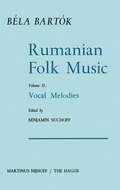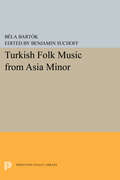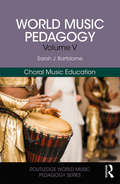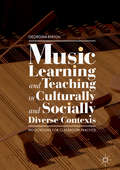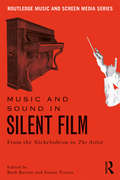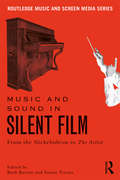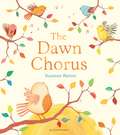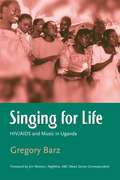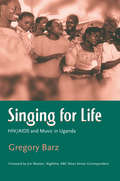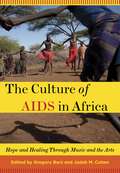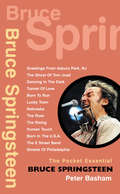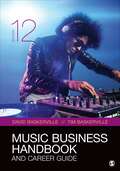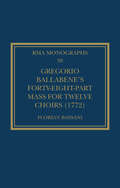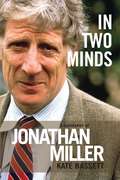- Table View
- List View
Rumanian Folk Music: Vocal Melodies (Bartok Archives Studies in Musicology #2)
by Bela Bartokhe editorial treatment of the second volume of Bela Bart6k's T Rumanian Folk Music is not dissimilar to that applied to Vol. I. The matter of poetic texts here, however, must allow for a sizeable increase in corrigenda and addenda. But first, let us delve into the source material upon which Vol. II is based. THE MANUSCRIPTS The various drafts of Vol. II fall into five basic categories of editorial process: music, texts, notes to the melodies (and texts), preface, and 1 miscellaneous reference material. M usic.-The first draft comprises field recording transcriptions, and notations made on the spot when recording was not possible. Bart6k left behind the bulk of this material when he emigrated to the United States in October, 1940 (The complete poetic text appears together with the music in each transcription).2 The second draft, uncorrected, comprises 304 pages printed by photo 3 offset process from master sheets. The third draft, reproduced from 667 pages of master sheets, is 1 All are contained in the New York Bartok Archives (hereinafter referred to as the BA) in envelopes designated by the author as Nos. 82-83, 85-86, 88, 90-97, 100, 102, and 106-107. See fn. 12 of the editorial Preface to Vol. I for the complete listing of the Rumanian folk' music MS.
Turkish Folk Music from Asia Minor
by Bela Bartok Benjamin SuchoffThis book is a substantial and thorough musicological analysis of Turkish folk music. It reproduces in facsimile Bartók's autograph record of eighty seven vocal and instrumental peasant melodies of the Yürük Tribes, a nomadic people in southern Anatolia. Bartók's introduction includes his annotations of the melodies, texts, and translations and establishes a connection between Old Hungarian and Old Turkish folk music.Begun in 1936 and completed in 1943, the work was Bartók's last major essay. The editor, Dr. Benjamin Suchoff, has provided an historical introduction and a chronology of the various manuscript versions. An afterword by Kurt Reinhard describes recent research in Turkish ethnomusicology and gives a contemporary assessment of Bartók's field work in Turkey. Appendices prepared by the editor include an index of themes compiled by computer.Originally published in 1976.The Princeton Legacy Library uses the latest print-on-demand technology to again make available previously out-of-print books from the distinguished backlist of Princeton University Press. These editions preserve the original texts of these important books while presenting them in durable paperback and hardcover editions. The goal of the Princeton Legacy Library is to vastly increase access to the rich scholarly heritage found in the thousands of books published by Princeton University Press since its founding in 1905.
World Music Pedagogy, Volume V: Choral Music Education (Routledge World Music Pedagogy Series)
by Sarah J. BartolomeWorld Music Pedagogy, Volume V: Choral Music Education explores specific applications of the World Music Pedagogy process to choral music education in elementary, middle, and high school contexts, as well as within community settings. The text provides clear and accessible information to help choral music educators select, rehearse, and perform a diverse global repertoire. It also guides directors in creating a rich cultural context for learners, emphasizing listening, moving, and playing activities as meaningful music-making experiences. Commentary on quality, commercially available world music repertoire bridges the gap between the philosophy of World Music Pedagogy and the realities of the performance-based choral classroom. All chapters open with a series of vignettes that illuminate the variety of possibilities within multiple K-12 contexts, providing the reader with a sense of how the ideas presented might look "on the ground." Ready-to-integrate activities serve as concrete and pedagogically sound examples to guide directors as they develop their own instructional materials according to the needs of their choir. Content features choral and vocal music-making traditions from South and West Africa; Latin America; Southeast, East, and South Asia; the Pacific Islands; Australia; New Zealand; Scandinavia; and the Baltics.
World Music Pedagogy, Volume V: Choral Music Education (Routledge World Music Pedagogy Series)
by Sarah J. BartolomeWorld Music Pedagogy, Volume V: Choral Music Education explores specific applications of the World Music Pedagogy process to choral music education in elementary, middle, and high school contexts, as well as within community settings. The text provides clear and accessible information to help choral music educators select, rehearse, and perform a diverse global repertoire. It also guides directors in creating a rich cultural context for learners, emphasizing listening, moving, and playing activities as meaningful music-making experiences. Commentary on quality, commercially available world music repertoire bridges the gap between the philosophy of World Music Pedagogy and the realities of the performance-based choral classroom. All chapters open with a series of vignettes that illuminate the variety of possibilities within multiple K-12 contexts, providing the reader with a sense of how the ideas presented might look "on the ground." Ready-to-integrate activities serve as concrete and pedagogically sound examples to guide directors as they develop their own instructional materials according to the needs of their choir. Content features choral and vocal music-making traditions from South and West Africa; Latin America; Southeast, East, and South Asia; the Pacific Islands; Australia; New Zealand; Scandinavia; and the Baltics.
Music Learning and Teaching in Culturally and Socially Diverse Contexts: Implications for Classroom Practice
by Georgina BartonThis book examines the inter-relationship between music learning and teaching, and culture and society: a relationship that is crucial to comprehend in today’s classrooms. The author presents case studies from diverse music learning and teaching contexts – including South India and Australia and online learning environments – to compare the modes of transmission teachers use to share their music knowledge and skills. It is imperative to understand the ways in which culture and society can in fact influence music teachers’ beliefs and experiences: and in understanding, there is potential to improve intercultural approaches to music education more generally. In increasingly diverse schools, the author highlights the need for culturally appropriate approaches to music planning, assessment and curricula. Thus, music teachers and learners will be able to understand the diversity of music education, and be encouraged to embrace a variety of methods and approaches in their own teaching. This inspiring book will be of interest and value to all those involved in teaching and learning music in various contexts.
Music Learning and Teaching in Culturally and Socially Diverse Contexts: Implications for Classroom Practice
by Georgina BartonThis book examines the inter-relationship between music learning and teaching, and culture and society: a relationship that is crucial to comprehend in today’s classrooms. The author presents case studies from diverse music learning and teaching contexts – including South India and Australia and online learning environments – to compare the modes of transmission teachers use to share their music knowledge and skills. It is imperative to understand the ways in which culture and society can in fact influence music teachers’ beliefs and experiences: and in understanding, there is potential to improve intercultural approaches to music education more generally. In increasingly diverse schools, the author highlights the need for culturally appropriate approaches to music planning, assessment and curricula. Thus, music teachers and learners will be able to understand the diversity of music education, and be encouraged to embrace a variety of methods and approaches in their own teaching. This inspiring book will be of interest and value to all those involved in teaching and learning music in various contexts.
Music And Sound In Silent Film: From The Nickelodeon To The Artist (PDF)
by Ruth Barton Simon TreziseDespite their name, the silent films of the early cinematic era were frequently accompanied by music and other sound elements of many kinds, including mechanical instruments, live performers, and audience sing-alongs. The 12 chapters in this concise book explore the multitude of functions filled by music in the rapidly changing context of the silent film era, as the concept of cinema itself developed. Examples are drawn from around the globe and across the history of silent film, both during the classic era of silent film and later uses of the silent format. With contributors drawn from film studies and music disciplines, and including both senior and emerging scholars, Music and Sound in Silent Film offers an essential introduction to the origins of film music and the cinematic art form.
Music And Sound In Silent Film: From The Nickelodeon To The Artist
by Ruth Barton Simon TreziseDespite their name, the silent films of the early cinematic era were frequently accompanied by music and other sound elements of many kinds, including mechanical instruments, live performers, and audience sing-alongs. The 12 chapters in this concise book explore the multitude of functions filled by music in the rapidly changing context of the silent film era, as the concept of cinema itself developed. Examples are drawn from around the globe and across the history of silent film, both during the classic era of silent film and later uses of the silent format. With contributors drawn from film studies and music disciplines, and including both senior and emerging scholars, Music and Sound in Silent Film offers an essential introduction to the origins of film music and the cinematic art form.
Music and Sound in Silent Film: From the Nickelodeon to The Artist
by Ruth Barton Simon TreziseDespite their name, the silent films of the early cinematic era were frequently accompanied by music and other sound elements of many kinds, including mechanical instruments, live performers, and audience sing-alongs. The 12 chapters in this concise book explore the multitude of functions filled by music in the rapidly changing context of the silent film era, as the concept of cinema itself developed. Examples are drawn from around the globe and across the history of silent film, both during the classic era of silent film and later uses of the silent format. With contributors drawn from film studies and music disciplines, and including both senior and emerging scholars, Music and Sound in Silent Film offers an essential introduction to the origins of film music and the cinematic art form.
The Dawn Chorus
by Suzanne BartonPeep awakes one morning to the sound of a beautiful song - but where is it coming from?It's the Dawn Chorus! And Peep is desperate to sing with them. But no matter how hard he tries, he just can't make it happen. Little does Peep know, he's just about to meet someone very special who will show him just how enchanting nightingales like him can be . . .A heartfelt story, exceptionally illustrated by exciting new author-illustrator Suzanne Barton.
Singing For Life: HIV/AIDS and Music in Uganda
by Gregory BarzFirst Published in 2006. Routledge is an imprint of Taylor & Francis, an informa company.
Singing For Life: HIV/AIDS and Music in Uganda
by Gregory BarzFirst Published in 2006. Routledge is an imprint of Taylor & Francis, an informa company.
The Culture of AIDS in Africa: Hope and Healing Through Music and the Arts
by Gregory Barz Judah M. CohenThe Culture of AIDS in Africa enters into the many worlds of expression brought forth across this vast continent by the ravaging presence of HIV/AIDS. Africans and non-Africans, physicians and social scientists, journalists and documentarians share here a common and essential interest in understanding creative expression in crushing and uncertain times. They investigate and engage the social networks, power relationships, and cultural structures that enable the arts to convey messages of hope and healing, and of knowledge and good counsel to the wider community. And from Africa to the wider world, they bring intimate, inspiring portraits of the performers, artists, communities, and organizations that have shared with them their insights and the sense they have made of their lives and actions from deep within this devastating epidemic. Covering the wide expanse of the African continent, the 30 chapters include explorations of, for example, the use of music to cope with AIDS; the relationship between music, HIV/AIDS, and social change; visual approaches to HIV literacy; radio and television as tools for "edutainment;" several individual artists' confrontations with HIV/AIDS; various performance groups' response to the epidemic; combating HIV/AIDS with local cultural performance; and more. Source material, such as song lyrics and interviews, weaves throughout the collection, and contributions by editors Gregory Barz and Judah M. Cohen bookend the whole, to bring together a vast array of perspectives and sources into a nuanced and profoundly affective portrayal of the intricate relationship between HIV/AIDS and the arts in Africa.
Shadows in the Field: New Perspectives for Fieldwork in Ethnomusicology
by Gregory F. Barz Timothy J. CooleyEthnomusicological fieldwork has significantly changed since the end of the the 20th century. Ethnomusicology is in a critical moment that requires new perspecitves on fieldwork - perspectives that are not addressed in the standard guides to ethnomusicological or anthropological method. The focus in ethnomusicological writing and teaching has traditionally centered around analyses and ethnographic representations of musical cultures, rather than on the personal world of understanding, experience, knowing, and doing fieldwork. Shadows in the Field deliberately shifts the focus of ethnomusicology and of ethnography in general from representation (text) to experience (fieldwork). The "new fieldwork" moves beyond mere data collection and has become a defining characteristic of ethnomusicology that engages the scholar in meaningful human contexts. In this new edition of Shadows in the Field, renowned ethnomusicologists explore the roles they themselves act out while performing fieldwork and pose significant questions for the field: What are the new directions in ethnomusicological fieldwork? Where does fieldwork of "the past" fit into these theories? And above all, what do we see when we acknowledge the shadows we cast in the field? The second edition of Shadows in the Field includes updates of all existing chapters, a new preface by Bruno Nettl, and seven new chapters addressing critical issues and concerns that have become increasingly relevant since the first edition.
The Operas of Giuseppe Verdi
by Abramo BaseviAbramo Basevi published his study of Verdi’s operas in Florence in 1859, in the middle of the composer’s career. The first thorough, systematic examination of Verdi’s operas, it covered the twenty works produced between 1842 and 1857—from Nabucco and Macbeth to Il trovatore, La traviata, and Aroldo. But while Basevi’s work is still widely cited and discussed—and nowhere more so than in the English-speaking world—no translation of the entire volume has previously been available. The Operas of Giuseppe Verdi fills this gap, at the same time providing an invaluable critical apparatus and commentary on Basevi’s work. As a contemporary of Verdi and a trained musician, erudite scholar, and critic conversant with current and past operatic repertories, Basevi presented pointed discussion of the operas and their historical context, offering today’s readers a unique window into many aspects of operatic culture, and culture in general, in Verdi’s Italy. He wrote with precision on formal aspects, use of melody and orchestration, and other compositional features, which made his study an acknowledged model for the growing field of music criticism. Carefully annotated and with an engaging introduction and detailed glossary by editor Stefano Castelvecchi, this translation illuminates Basevi’s musical and historical references as well as aspects of his language that remain difficult to grasp even for Italian readers. Making Basevi’s important contribution to our understanding of Verdi and his operas available to a broad audience for the first time, The Operas of Giuseppe Verdi will delight scholars and opera enthusiasts alike.
The Operas of Giuseppe Verdi
by Abramo BaseviAbramo Basevi published his study of Verdi’s operas in Florence in 1859, in the middle of the composer’s career. The first thorough, systematic examination of Verdi’s operas, it covered the twenty works produced between 1842 and 1857—from Nabucco and Macbeth to Il trovatore, La traviata, and Aroldo. But while Basevi’s work is still widely cited and discussed—and nowhere more so than in the English-speaking world—no translation of the entire volume has previously been available. The Operas of Giuseppe Verdi fills this gap, at the same time providing an invaluable critical apparatus and commentary on Basevi’s work. As a contemporary of Verdi and a trained musician, erudite scholar, and critic conversant with current and past operatic repertories, Basevi presented pointed discussion of the operas and their historical context, offering today’s readers a unique window into many aspects of operatic culture, and culture in general, in Verdi’s Italy. He wrote with precision on formal aspects, use of melody and orchestration, and other compositional features, which made his study an acknowledged model for the growing field of music criticism. Carefully annotated and with an engaging introduction and detailed glossary by editor Stefano Castelvecchi, this translation illuminates Basevi’s musical and historical references as well as aspects of his language that remain difficult to grasp even for Italian readers. Making Basevi’s important contribution to our understanding of Verdi and his operas available to a broad audience for the first time, The Operas of Giuseppe Verdi will delight scholars and opera enthusiasts alike.
The Operas of Giuseppe Verdi
by Abramo BaseviAbramo Basevi published his study of Verdi’s operas in Florence in 1859, in the middle of the composer’s career. The first thorough, systematic examination of Verdi’s operas, it covered the twenty works produced between 1842 and 1857—from Nabucco and Macbeth to Il trovatore, La traviata, and Aroldo. But while Basevi’s work is still widely cited and discussed—and nowhere more so than in the English-speaking world—no translation of the entire volume has previously been available. The Operas of Giuseppe Verdi fills this gap, at the same time providing an invaluable critical apparatus and commentary on Basevi’s work. As a contemporary of Verdi and a trained musician, erudite scholar, and critic conversant with current and past operatic repertories, Basevi presented pointed discussion of the operas and their historical context, offering today’s readers a unique window into many aspects of operatic culture, and culture in general, in Verdi’s Italy. He wrote with precision on formal aspects, use of melody and orchestration, and other compositional features, which made his study an acknowledged model for the growing field of music criticism. Carefully annotated and with an engaging introduction and detailed glossary by editor Stefano Castelvecchi, this translation illuminates Basevi’s musical and historical references as well as aspects of his language that remain difficult to grasp even for Italian readers. Making Basevi’s important contribution to our understanding of Verdi and his operas available to a broad audience for the first time, The Operas of Giuseppe Verdi will delight scholars and opera enthusiasts alike.
The Operas of Giuseppe Verdi
by Abramo BaseviAbramo Basevi published his study of Verdi’s operas in Florence in 1859, in the middle of the composer’s career. The first thorough, systematic examination of Verdi’s operas, it covered the twenty works produced between 1842 and 1857—from Nabucco and Macbeth to Il trovatore, La traviata, and Aroldo. But while Basevi’s work is still widely cited and discussed—and nowhere more so than in the English-speaking world—no translation of the entire volume has previously been available. The Operas of Giuseppe Verdi fills this gap, at the same time providing an invaluable critical apparatus and commentary on Basevi’s work. As a contemporary of Verdi and a trained musician, erudite scholar, and critic conversant with current and past operatic repertories, Basevi presented pointed discussion of the operas and their historical context, offering today’s readers a unique window into many aspects of operatic culture, and culture in general, in Verdi’s Italy. He wrote with precision on formal aspects, use of melody and orchestration, and other compositional features, which made his study an acknowledged model for the growing field of music criticism. Carefully annotated and with an engaging introduction and detailed glossary by editor Stefano Castelvecchi, this translation illuminates Basevi’s musical and historical references as well as aspects of his language that remain difficult to grasp even for Italian readers. Making Basevi’s important contribution to our understanding of Verdi and his operas available to a broad audience for the first time, The Operas of Giuseppe Verdi will delight scholars and opera enthusiasts alike.
Bruce Springsteen (Pocket Essential Ser.)
by Peter BashamBruce Springsteen grew from a dishevelled, bearded singer of youthful street ballads to become the hottest name in the rock world - twice. The resilience of the New Jersey troubadour has seen him top the album charts in four successive decades, and his epic world tours with the legendarily hard-working E Street Band are still sell-outs well into the new millennium. Once seen as another Bob Dylan wannabe, Springsteen became rock's definitive chronicler of blue-collar life and inheritor of the spirit of Woody Guthrie. When the world needed a compassionate artistic statement, he delivered. This guide examines the growth of Bruce Springsteen's career, from the optimistic youth who wrote Born To Run to the respected heavyweight songwriter of today.
Music Business Handbook And Career Guide (PDF)
by David Baskerville Timothy BaskervilleThe Twelfth Edition of this powerhouse best-selling text maintains its tradition as the most comprehensive, up-to-date guide to the music industry in all of its diversity. Readers new to the music business and seasoned professionals alike will find David Baskerville and Tim Baskerville’s handbook the go-to source, regardless of their specialty within the music field. Music Business Handbook and Career Guide is ideal for introductory courses such as Introduction to the Music Business, Music and Media, and other survey courses as well as more specialized courses such as the record industry, music careers, artist management, and more. The fully updated Twelfth Edition includes a comprehensive discussion of the streaming revolution and its impact on all parts of the value chain, including composers, performing artists, publishers, and labels. The book also analyzes shifts in the competing platforms of consumption ranging from fast-shrinking physical formats and broadcasting to downloads and subscription services. This edition offers more vignettes than ever, illustrating how individuals in different industry roles advanced their careers, as well as how they’ve adjusted to the intertwining influences of technology, law, and culture.
Gregorio Ballabene’s Forty-eight-part Mass for Twelve Choirs (Royal Musical Association Monographs)
by Florian BassaniNeither Spem in alium, the widely acclaimed ‘songe of fortie partes’ by Thomas Tallis, nor Alessandro Striggio’s forty-part Mass is the largest-scale counterpoint work in Western music. The actual winner is Gregorio Ballabene, a relatively unknown Roman maestro di cappella, a contemporary of Giovanni Paisiello, Joseph Haydn and Luigi Boccherini, who composed in forty-eight parts for twelve choirs. His Mass saw only a public rehearsal and was never performed liturgically despite all of Ballabene’s efforts to promote it. On closer inspection, however, the work deserves special consideration as a piece of outstanding combinatory creativity – the product of a talent able to conceive, structure and realise a project of colossal dimensions. It might even be claimed that if Charles Burney had gained knowledge of it, all derogatory comments by nineteenth-century music historians would not have succeeded in extinguishing the interest of later generations. Ballabene’s Mass has remained completely unstudied until today, even though the score survives in prominent collections. This study offers, for the first time, a historical and analytical perspective on this overlooked manifestation of a very individual musical intelligence.
Gregorio Ballabene’s Forty-eight-part Mass for Twelve Choirs (Royal Musical Association Monographs)
by Florian BassaniNeither Spem in alium, the widely acclaimed ‘songe of fortie partes’ by Thomas Tallis, nor Alessandro Striggio’s forty-part Mass is the largest-scale counterpoint work in Western music. The actual winner is Gregorio Ballabene, a relatively unknown Roman maestro di cappella, a contemporary of Giovanni Paisiello, Joseph Haydn and Luigi Boccherini, who composed in forty-eight parts for twelve choirs. His Mass saw only a public rehearsal and was never performed liturgically despite all of Ballabene’s efforts to promote it. On closer inspection, however, the work deserves special consideration as a piece of outstanding combinatory creativity – the product of a talent able to conceive, structure and realise a project of colossal dimensions. It might even be claimed that if Charles Burney had gained knowledge of it, all derogatory comments by nineteenth-century music historians would not have succeeded in extinguishing the interest of later generations. Ballabene’s Mass has remained completely unstudied until today, even though the score survives in prominent collections. This study offers, for the first time, a historical and analytical perspective on this overlooked manifestation of a very individual musical intelligence.
Little Richard's Here's Little Richard (33 1/3)
by Jordan BassettFrom male bisexuality to religion in pop, Little Richard spent the 1950s pioneering ideas that are still too challenging for the mainstream. As a Black multimillionaire rock star, he was the most exciting person on the planet between 1955 and 1957, the years in which his seismic debut album was created.Featuring new interviews with famous fans including Sir Elton John, Dave Grohl, Joan Jett and Nile Rodgers, this is the first in-depth look at Here's Little Richard since Richard Penniman's death in May 2020. The book explores his roots in the queer underground of the American South, a scene so progressive you'd scarcely believe it thrived seven decades ago, and early rebel music such as jump blues, which soon collided with the emerging juggernaut that was rock'n'roll. When that weird alchemy occurred, the self-proclaimed Living Flame was ready to spark the likes of The Beatles, David Bowie and Prince into existence. Those close to the tale pinpoint the ways in which 'Long Tall Sally' and 'Tutti Frutti' remain omnipresent – and why the latter was the 'WAP' of its day. This is the story of how Little Richard changed the world in 28 minutes and 30 seconds. A-wop-bop-a-loo-bop-a-lop-bam-boom!
Little Richard's Here's Little Richard (33 1/3)
by Jordan BassettFrom male bisexuality to religion in pop, Little Richard spent the 1950s pioneering ideas that are still too challenging for the mainstream. As a Black multimillionaire rock star, he was the most exciting person on the planet between 1955 and 1957, the years in which his seismic debut album was created.Featuring new interviews with famous fans including Sir Elton John, Dave Grohl, Joan Jett and Nile Rodgers, this is the first in-depth look at Here's Little Richard since Richard Penniman's death in May 2020. The book explores his roots in the queer underground of the American South, a scene so progressive you'd scarcely believe it thrived seven decades ago, and early rebel music such as jump blues, which soon collided with the emerging juggernaut that was rock'n'roll. When that weird alchemy occurred, the self-proclaimed Living Flame was ready to spark the likes of The Beatles, David Bowie and Prince into existence. Those close to the tale pinpoint the ways in which 'Long Tall Sally' and 'Tutti Frutti' remain omnipresent – and why the latter was the 'WAP' of its day. This is the story of how Little Richard changed the world in 28 minutes and 30 seconds. A-wop-bop-a-loo-bop-a-lop-bam-boom!
In Two Minds: A Biography of Jonathan Miller
by Kate BassettIn Two Minds... is the story of Jonathan Miller, one of post war Britain's most intriguing polymaths. Descended from immigrants who fled Tsarist anti-Semitism to become shopkeepers in Ireland and London's East End, Miller was born into an intellectual milieu, between Bloomsbury and Harley Street - the son of a novelist and a leading child psychiatrist. Miller trained as a doctor but then forged a career as a stellar comedian and as a world renowned theatre and opera director. He is a controversial humorist, public intellectual and TV personality. As a star in the ground breaking satirical revue Beyond the Fringe, he shot to fame alongside Peter Cook, Dudley Moore and Alan Bennett. His expertise and interests encompass many areas, from medicine (he wrote and presented the hugely acclaimed BBC documentary series The Body in Question) to the history of art, Mozart, atheism and the nature of laughter. Jonathan Miller is one of the most multi-talented Britons of his generation, celebrated for his dazzling intelligence and anti-establishmentarian wit. This is the first comprehensive biography of him, written by leading arts journalist Kate Bassett (the Independent on Sunday). Drawing on in-depth interviews, it is an entertaining and illuminating portrait of a fascinatingly complex man. ‘I suppose it is true, my life does resemble a butterfly’s existence, moving around from one flower to the next. But, of course, butterflies do pollinate. There is a point to their activity. I hope there is to mine.’ Jonathan Miller ‘He was always my idea of an impossible Renaissance man … he has been a benign and hopeful presence in my life, and the life of my mind, from Cambridge until now.’ A.S. Byatt ‘He was groundbreaking, willing to take risks. His impact upon the opera world has been, without question, one of the most significant of any director in modern times…part of all the schools of thought whose developments we are now experiencing.’ Thomas Hampson ‘If he’d been born French, there would be streets named after him.’ John Fortune
